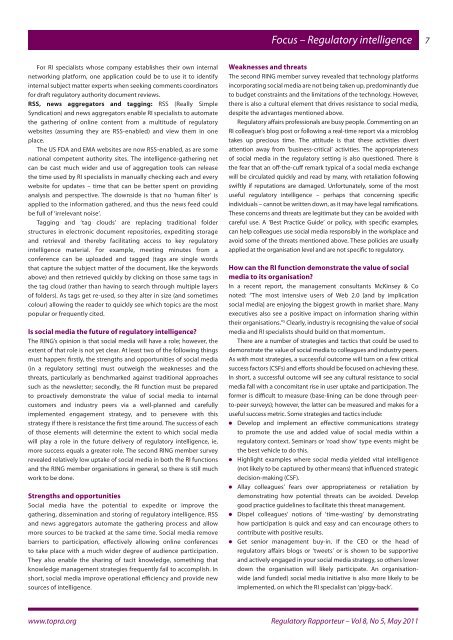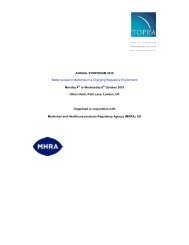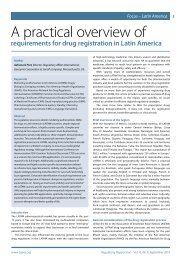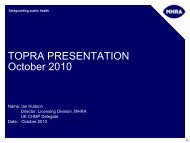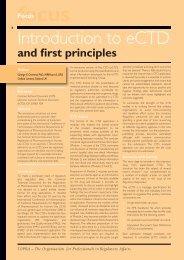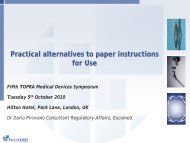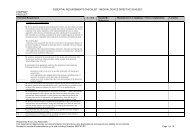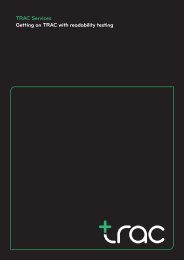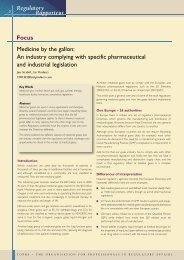Sharing regulatory intelligence: Are newsletters here to ... - TOPRA
Sharing regulatory intelligence: Are newsletters here to ... - TOPRA
Sharing regulatory intelligence: Are newsletters here to ... - TOPRA
- No tags were found...
You also want an ePaper? Increase the reach of your titles
YUMPU automatically turns print PDFs into web optimized ePapers that Google loves.
Focus – Regula<strong>to</strong>ry <strong>intelligence</strong>7For RI specialists whose company establishes their own internalnetworking platform, one application could be <strong>to</strong> use it <strong>to</strong> identifyinternal subject matter experts when seeking comments coordina<strong>to</strong>rsfor draft <strong>regula<strong>to</strong>ry</strong> authority document reviews.RSS, news aggrega<strong>to</strong>rs and tagging: RSS (Really SimpleSyndication) and news aggrega<strong>to</strong>rs enable RI specialists <strong>to</strong> au<strong>to</strong>matethe gathering of online content from a multitude of <strong>regula<strong>to</strong>ry</strong>websites (assuming they are RSS-enabled) and view them in oneplace.The US FDA and EMA websites are now RSS-enabled, as are somenational competent authority sites. The <strong>intelligence</strong>-gathering netcan be cast much wider and use of aggregation <strong>to</strong>ols can releasethe time used by RI specialists in manually checking each and everywebsite for updates – time that can be better spent on providinganalysis and perspective. The downside is that no ‘human filter’ isapplied <strong>to</strong> the information gat<strong>here</strong>d, and thus the news feed couldbe full of ‘irrelevant noise’.Tagging and ‘tag clouds’ are replacing traditional folderstructures in electronic document reposi<strong>to</strong>ries, expediting s<strong>to</strong>rageand retrieval and t<strong>here</strong>by facilitating access <strong>to</strong> key <strong>regula<strong>to</strong>ry</strong><strong>intelligence</strong> material. For example, meeting minutes from aconference can be uploaded and tagged (tags are single wordsthat capture the subject matter of the document, like the keywordsabove) and then retrieved quickly by clicking on those same tags inthe tag cloud (rather than having <strong>to</strong> search through multiple layersof folders). As tags get re-used, so they alter in size (and sometimescolour) allowing the reader <strong>to</strong> quickly see which <strong>to</strong>pics are the mostpopular or frequently cited.Is social media the future of <strong>regula<strong>to</strong>ry</strong> <strong>intelligence</strong>?The RING’s opinion is that social media will have a role; however, theextent of that role is not yet clear. At least two of the following thingsmust happen: firstly, the strengths and opportunities of social media(in a <strong>regula<strong>to</strong>ry</strong> setting) must outweigh the weaknesses and thethreats, particularly as benchmarked against traditional approachessuch as the newsletter; secondly, the RI function must be prepared<strong>to</strong> proactively demonstrate the value of social media <strong>to</strong> internalcus<strong>to</strong>mers and industry peers via a well-planned and carefullyimplemented engagement strategy, and <strong>to</strong> persevere with thisstrategy if t<strong>here</strong> is resistance the first time around. The success of eachof those elements will determine the extent <strong>to</strong> which social mediawill play a role in the future delivery of <strong>regula<strong>to</strong>ry</strong> <strong>intelligence</strong>, ie,more success equals a greater role. The second RING member surveyrevealed relatively low uptake of social media in both the RI functionsand the RING member organisations in general, so t<strong>here</strong> is still muchwork <strong>to</strong> be done.Strengths and opportunitiesSocial media have the potential <strong>to</strong> expedite or improve thegathering, dissemination and s<strong>to</strong>ring of <strong>regula<strong>to</strong>ry</strong> <strong>intelligence</strong>. RSSand news aggrega<strong>to</strong>rs au<strong>to</strong>mate the gathering process and allowmore sources <strong>to</strong> be tracked at the same time. Social media removebarriers <strong>to</strong> participation, effectively allowing online conferences<strong>to</strong> take place with a much wider degree of audience participation.They also enable the sharing of tacit knowledge, something thatknowledge management strategies frequently fail <strong>to</strong> accomplish. Inshort, social media improve operational efficiency and provide newsources of <strong>intelligence</strong>.Weaknesses and threatsThe second RING member survey revealed that technology platformsincorporating social media are not being taken up, predominantly due<strong>to</strong> budget constraints and the limitations of the technology. However,t<strong>here</strong> is also a cultural element that drives resistance <strong>to</strong> social media,despite the advantages mentioned above.Regula<strong>to</strong>ry affairs professionals are busy people. Commenting on anRI colleague’s blog post or following a real-time report via a microblogtakes up precious time. The attitude is that these activities divertattention away from ‘business-critical’ activities. The appropriatenessof social media in the <strong>regula<strong>to</strong>ry</strong> setting is also questioned. T<strong>here</strong> isthe fear that an off-the-cuff remark typical of a social media exchangewill be circulated quickly and read by many, with retaliation followingswiftly if reputations are damaged. Unfortunately, some of the mostuseful <strong>regula<strong>to</strong>ry</strong> <strong>intelligence</strong> – perhaps that concerning specificindividuals – cannot be written down, as it may have legal ramifications.These concerns and threats are legitimate but they can be avoided withcareful use. A ‘Best Practice Guide’ or policy, with specific examples,can help colleagues use social media responsibly in the workplace andavoid some of the threats mentioned above. These policies are usuallyapplied at the organisation level and are not specific <strong>to</strong> <strong>regula<strong>to</strong>ry</strong>.How can the RI function demonstrate the value of socialmedia <strong>to</strong> its organisation?In a recent report, the management consultants McKinsey & Conoted: “The most intensive users of Web 2.0 [and by implicationsocial media] are enjoying the biggest growth in market share. Manyexecutives also see a positive impact on information sharing withintheir organisations.” 5 Clearly, industry is recognising the value of socialmedia and RI specialists should build on that momentum.T<strong>here</strong> are a number of strategies and tactics that could be used <strong>to</strong>demonstrate the value of social media <strong>to</strong> colleagues and industry peers.As with most strategies, a successful outcome will turn on a few criticalsuccess fac<strong>to</strong>rs (CSFs) and efforts should be focused on achieving these.In short, a successful outcome will see any cultural resistance <strong>to</strong> socialmedia fall with a concomitant rise in user uptake and participation. Theformer is difficult <strong>to</strong> measure (base-lining can be done through peer<strong>to</strong>-peersurveys); however, the latter can be measured and makes for auseful success metric. Some strategies and tactics include:l Develop and implement an effective communications strategy<strong>to</strong> promote the use and added value of social media within a<strong>regula<strong>to</strong>ry</strong> context. Seminars or ‘road show’ type events might bethe best vehicle <strong>to</strong> do this.l Highlight examples w<strong>here</strong> social media yielded vital <strong>intelligence</strong>(not likely <strong>to</strong> be captured by other means) that influenced strategicdecision-making (CSF).l Allay colleagues’ fears over appropriateness or retaliation bydemonstrating how potential threats can be avoided. Developgood practice guidelines <strong>to</strong> facilitate this threat management.l Dispel colleagues’ notions of ‘time-wasting’ by demonstratinghow participation is quick and easy and can encourage others <strong>to</strong>contribute with positive results.l Get senior management buy-in. If the CEO or the head of<strong>regula<strong>to</strong>ry</strong> affairs blogs or ‘tweets’ or is shown <strong>to</strong> be supportiveand actively engaged in your social media strategy, so others lowerdown the organisation will likely participate. An organisationwide(and funded) social media initiative is also more likely <strong>to</strong> beimplemented, on which the RI specialist can ‘piggy-back’.www.<strong>to</strong>pra.org Regula<strong>to</strong>ry Rapporteur – Vol 8, No 5, May 2011


